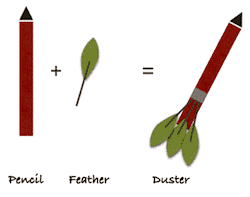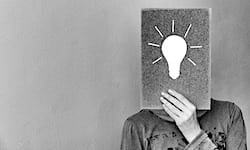Table of Contents
Increase creativity by actively looking for different associations.
“Creativity is just connecting things. When you ask creative people how they did something, they feel a little guilty because they didn’t really do it, they just saw something. It seemed obvious to them after a while. That’s because they were able to connect experiences they’ve had and synthesize new things.” – Steve Jobs
Some of the most groundbreaking ideas came about not by logical thinking, but by combining unrelated ideas and changing the paradigm completely. Larry Page and Sergey Brin didn’t try to make a faster or a more efficient search engine – they completely changed what a search engine should do. But how did they get the idea that eventually made Google?
By combining ideas from two previously unrelated domains! They used the concept of academic citations – a more cited journal article is likely an important one – into ranking websites and created their PageRank algorithm. That algorithm allowed them to surface higher quality links to their users that didn’t have to be manually curated.
Importance of Associational Thinking
 The ability to connect unrelated things, or associational thinking, is a fundamental process that underlies creative thinking. Professor Mednick, who created the Remote Associates Test for creativity, defines the creative thinking process as “the forming of associative elements into new combinations which either meet specified requirements or are in some way useful.” The more remote the elements, the more novel the solution. Consider how the structure of Benzene was discovered. August Kekule had a dream about a snake eating its own tail, which he couldn’t shake off. By connecting that image with his work on chemical structure, he got the idea of the cyclic structure of Benzene and made a significant contribution to the understanding of aromatic compounds.
The ability to connect unrelated things, or associational thinking, is a fundamental process that underlies creative thinking. Professor Mednick, who created the Remote Associates Test for creativity, defines the creative thinking process as “the forming of associative elements into new combinations which either meet specified requirements or are in some way useful.” The more remote the elements, the more novel the solution. Consider how the structure of Benzene was discovered. August Kekule had a dream about a snake eating its own tail, which he couldn’t shake off. By connecting that image with his work on chemical structure, he got the idea of the cyclic structure of Benzene and made a significant contribution to the understanding of aromatic compounds.
Finding Simple Pathways to Creativity
But is there a better way to increase creativity without having to wait for serendipity?
The answer is surprisingly simple – by actively looking for different associations! These different associations could be either internal or external. Internal connections are those that lie in the same problem domain but may not have been used together. One way to find internal connections is by combining various form and function attributes in different ways. External connections, on the other hand, combine ideas from completely different domains and often lead to much more novel ideas. Techniques like the using random stimulus like poem fragments or BruteThink where a random object is used as a trigger are examples of external associations. Our brain, because of its associative nature, is actually quite good at connecting unrelated ideas and combining them in a useful way.
 Playing games that help build associational thinking can improve creativity. For example, Chindogu, the Japanese art of “unuseless inventions” and Wacky Inventions are fun activities that allow people to combine unrelated objects in interesting ways to create a new product. These games use random stimuli to trigger the brain to think in different directions.
Playing games that help build associational thinking can improve creativity. For example, Chindogu, the Japanese art of “unuseless inventions” and Wacky Inventions are fun activities that allow people to combine unrelated objects in interesting ways to create a new product. These games use random stimuli to trigger the brain to think in different directions.
Creativity Can Be Simple and Fun
The simplest of all associative thinking games? Spotting shapes in clouds! A similar technique that Leonardo da Vinci often used was to throw a paint-filled sponge at a wall and try to make sense of the meaningless stains. Playing this game built up his ability to make remote associations that eventually helped him in many of his inventions. It’s always possible to find some way to connect unlikely elements, even if that leads to bizarre ideas occasionally. Like da Vinci himself said, “Realize that everything connects to everything else.”
Further Reading
- edCircuit – Dr. Pronita Mehrotra Articles
- The Conversation – What creativity really is – and why schools need it
- Education Week – The Quest for Creativity in Schools







